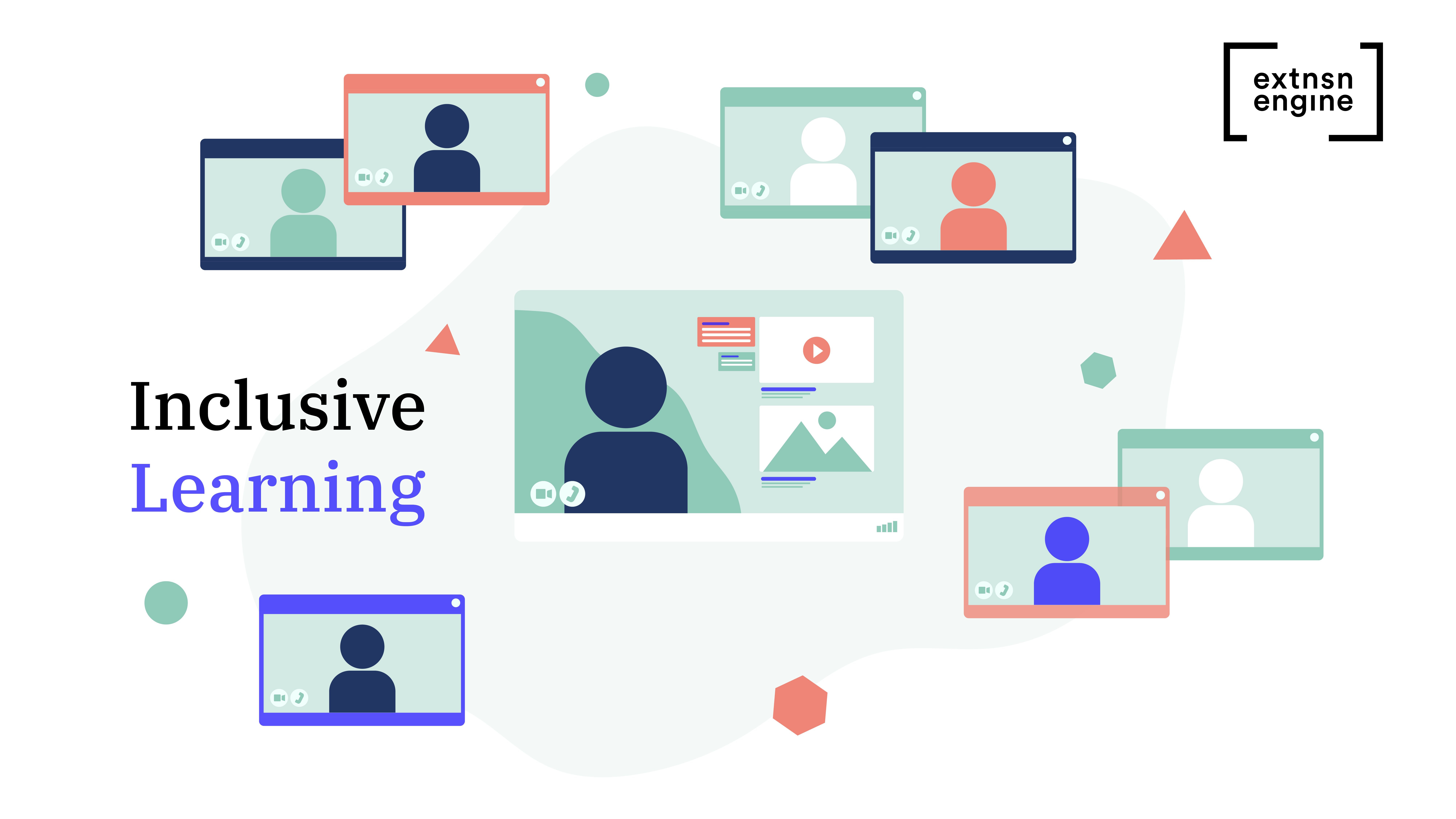Over the course of several roles I’ve served in education, it has been rewarding and exciting to see the increasing diversity of learners at every level. Yet even as the composition of the learners is changing, the design of the learning process remains relatively narrowly focused in ways that fall further and further short of inclusiveness. This disconnect makes learning more challenging just as the knowledge economy is demanding ever more and varied skills.
Increasingly, digital learning has been opening access to quality education for more people across geographic, cultural, and socioeconomic dimensions than ever before. But this broader range of people brings with it the imperative to reshape learning experiences to meet a greater diversity of needs. Inclusive Design enables us to incorporate the widest spectrum of learners into digital learning experiences with the end goal of helping all to learn at their full potential.
The landscape
The U.S. is becoming more diverse in several ways, and at an even faster rate than predicted just a decade ago. Demographics have changed dramatically over the last 50 years, and the decades ahead will be truly transformative. For example, focusing for a moment on racial composition, the 2020 census shows that, for the first time in the country’s history, the number of white Americans has decreased, not only as a share of the total population but also in terms of absolute numbers, while other racial groups have continued to grow.
 Source: “New 2020 census results show increased diversity countering decade-long declines in America’s white and youth populations,” by William H. Frey, The Brookings Institution
Source: “New 2020 census results show increased diversity countering decade-long declines in America’s white and youth populations,” by William H. Frey, The Brookings Institution
At the same time, the Americans with Disabilities Act (ADA) ensures that learners with physical or other differences are not left out for reasons unrelated to their ability to learn. Federal loan programs and private scholarships give more students the means to pursue higher education (which has grown so costly it is out of reach for many), while nonprofits create learning opportunities for even wider audiences. As a result, today’s learners are far more diverse than ever, and they will continue to grow more and more diverse over time.
Traditional education is not keeping up
Far too frequently, despite ever-increasing learner diversity, the learning process continues to be designed and delivered with a one-size-fits-all approach. In most cases, course and/or program design reflect a single cultural milieu. The traditional, mostly unchallenged presumption is that learning design (course content, resources, examples) will draw from the instructor’s life and/or scholarly context. That instructor’s framework is commonly that of a white male from a higher socioeconomic class and often doesn’t reflect the lived experiences and cultural richness of the increasingly diverse set of learners.
To succeed in such learning environments, many students have to play catch-up. In order to fit into the instructional paradigm, too many learners are forced to put on a kind of cultural, social, or even cognitive mask; must learn to use culturally unfamiliar language, idioms, and examples; and have to view issues from perspectives quite different from those with which they’ve grown up. Moreover, if the learning experience is delivered online, its design usually requires a high-speed internet connection — which we cannot assume is readily available to all learners, particularly those with economic challenges. Finally, digital designs don’t always accommodate learners with unique accessibility needs. And learners confront all these barriers before they get to the actual task of mastering the course material.
Studying effectively is challenging enough on its own. No learner should have the added burden of having to contort themselves to fit a learning experience not designed to include them. As Dr. Howard Gardner posited in his Theory of Multiple Intelligences, there is no single context for measuring intelligence, so why should there be only one way of teaching? Increased access is not enough; established learning paradigms must be adapted to fit today’s variety of diverse audiences in a range of settings.
The possibilities afforded by digital design offer higher education institutions, nonprofits, learning businesses, and other organizations unprecedented opportunities to design learning experiences around the needs of learners, ranging from where things are positioned on a screen to examples and illustrations in which learners recognize themselves.
Obligation and advantages
How each person learns is shaped by a variety of dimensions, and every design decision has the potential to include or exclude whole segments of learners. A corollary of diversity, equity, and inclusion (DEI) is that one size will never fit all, no matter how comfortable it is for the majority. As an example, the left-to-right direction of written text may seem standard, but for learners whose first language is Hebrew, Arabic, Chinese, Japanese, Korean, or other right-to-left script languages, that feels entirely foreign.
Every individual is different, and so are the audiences served by each learning organization. But every organization wants to build the most effective learning opportunity they can. They want to reach as many people as possible and share knowledge and tools that help others develop as students, professionals, leaders, community members, or in other roles. Today, that goal necessitates finding ways to meet all learners where they are.
Inclusive Design prioritizes understanding how DEI — in the broadest sense — can and should inform all aspects of the digital learning experience. Inclusive Design recognizes each individual and welcomes them into the learning process. Instead of expecting conformity, Inclusive Design rewards participation as an expression of each person’s unique value in the educational experience. To the extent that learning is set within a human (rather than an abstract) context, most learners benefit by being able to envision themselves as part of the educational story. Creating a space for learners to remain authentic respects the learner, makes learning easier, and leads to more powerful learning outcomes.
By taking advantage of diversity, we also make better decisions. We get better actions. We get better results. A recent McKinsey study demonstrated the benefits of diversity in terms of organizational performance. Conclusion: Organizations with more diversity perform better.
 Source: “Diversity wins: How inclusion matters,” McKinsey & Company
Source: “Diversity wins: How inclusion matters,” McKinsey & Company
Custom learning experiences enable inclusive design
In the digital world, we’re not stuck with fixed classrooms, a single set of blackboards, or even set schedules. We can change, adapt, and redesign with much greater flexibility than is feasible within physical campuses, classrooms, and laboratories. We must take advantage of that flexibility to design new programs and be more inclusive in our learning design and not simply carry analogue concepts and practices into the digital world.
Extension Engine’s clients want outstanding custom digital learning experiences that reflect their learners’ needs and help them achieve their defined goals. These digital learning experiences aim for the best solutions for each organization’s learners. All of these organizations are investing in custom experiences to ensure that learning is effective. That usually means rethinking every aspect of the learning landscape, from strategy to programs to technology.
Extension Engine has discovered that meeting an organization’s needs for effective learning experiences begins with understanding their learners. That’s why step one of any project involves research into the individuals and communities our partners serve. From the lens of Inclusive Design, that work involves developing not just demographics but psychographics and personas. No matter the focus of your organization, your target audience is becoming more and more diverse in so many ways — including aspects that may not be as visible. The obligation and advantage is to recognize all aspects of inclusivity and support everyone, no matter how homogenous they may appear.
How do we chart the topography of that “terrain”? Today, it rarely resembles a flat cornfield. Our challenge is to design a learning system that recognizes all the hills, valleys, mountains, and rivers.
Extension Engine tailors Inclusive Design according to the learning populations of each partner. By definition, the strategy, design, and implementation will vary by organization. Depending upon the composition of the learner population, the Inclusive Design for one client is frequently quite different from the Inclusive Design for another.
In that regard, inclusivity is just like the other four elements Extension Engine uses to design solutions that fit learners’ and organizations’ needs: learner-centered content, active learning, social connections, and real-world outcomes. The balance and form of these “five ingredients” are customized for each of Extension Engine’s partners, but they’re all essential to high engagement at scale — to learning that motivates while expanding an organization’s reach without expending resources at the same rate.
Extension Engine’s client partners expect us to design custom learning experiences not simply for where their learner populations are, but also for where they’re headed. That means skating like Bobby Orr — to where the puck is going to be! Fortunately, that direction is clear: Our client partners are headed for greater and greater diversity. That’s why Inclusive Design will become a foundational element of Extension Engine’s approach to designing custom digital learning experiences.
The digital space provides an opportunity to focus on the learner rather than adhere to conventions of the past. We can design and build solutions that enable learning organizations to reach every student. Together, we can establish learning environments that meet every student where they are — enabling them to reach their full potential. Isn’t that what learning design should be all about?
Keep learning
Senior Learning Experience (LX) Designer Lexie Bryan, LX Designer Marc Campasano, and User Experience (UX) Designer Justice, talk about including accessibility in their work with Extension Engine’s clients.
Designing for Accessibility: An Expectation, Not an Afterthought



